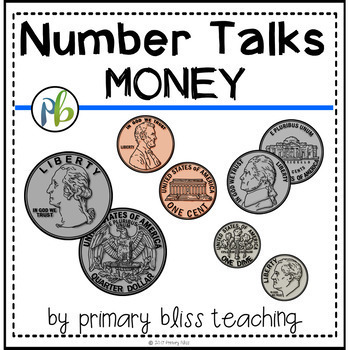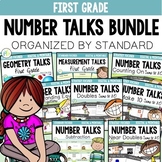MONEY NUMBER TALKS
- Zip
- Google Apps™

Also included in
- Math Talks are hands-down the best math warm-up activities for developing number sense and computational fluency. And these Number Talks for first grade make implementing Number Talks easier than ever.This seriously NO PREP resource provides daily lessons that are thought-provoking and engaging forPrice $37.00Original Price $67.50Save $30.50
Description
These PAPERLESS NUMBER TALKS are about to make your life so much easier! These money-centered number talks will really get your students thinking and engaged in student-to-student discourse during math instruction and, best of all, they are literally ready for you to just click and teach!
WE'VE ADDED A UNIT COMPATIBLE WITH GOOGLE SLIDES.
THESE UNITS CAN BE USED ON INTERACTIVE WHITEBOARDS, ARE COMPATIBLE WITH GOOGLE SLIDES, OR CAN BE PRINTED OUT. ALL THREE VERSIONS ARE INCLUDED.
These number talks can be used either during small group instruction or whole group instruction. They are a perfect addition to your money unit. Just print them off, display them under your document camera, and listen to your students engage in great mathematical conversations as they persevere in problem-solving.
(If you have an interactive whiteboard, you can also simply display the number talks on that.)
Testimonials:
"I loved being able to add these into the other number talks I bought from you. I like the progression of like coins moving to mixed coin counting."
"I'm new to Number Talks and this is a great resource. Very easy to pick up and teach."
Money Number Talks include these categories:
Just Pennies
Just Nickels
Just Dimes
Just Quarters
Nickel and Penny Combinations
Nickel and Dime Combinations
Dime and Penny Combinations
Dime, Nickel and Penny Combinations
Quarter, Dime, Nickel, and Penny Combinations
You may also like:
Number Talks - A Yearlong Program for First Grade
Number Talks - A Yearlong Program for Second Grade
Number Talks - A Yearlong Program for Third Grade
Numberless Word Problems - Addition and Subtraction Within 20
Numberless Word Problems - Addition and Subtraction Within 100
Make a Ten Computational Fluency Unit
Doubles and Near Doubles Computational Fluency Unit
Count On Computational Fluency Unit
============================================================================
Click HERE to follow us and receive notifications for sales, new resources, and FREEBIES!
PLEASE LEAVE FEEDBACK on this product to earn TPT credits that can be used on future purchases!
Happy Teaching!
Cindy & Becky
Team Primary Bliss Teaching






